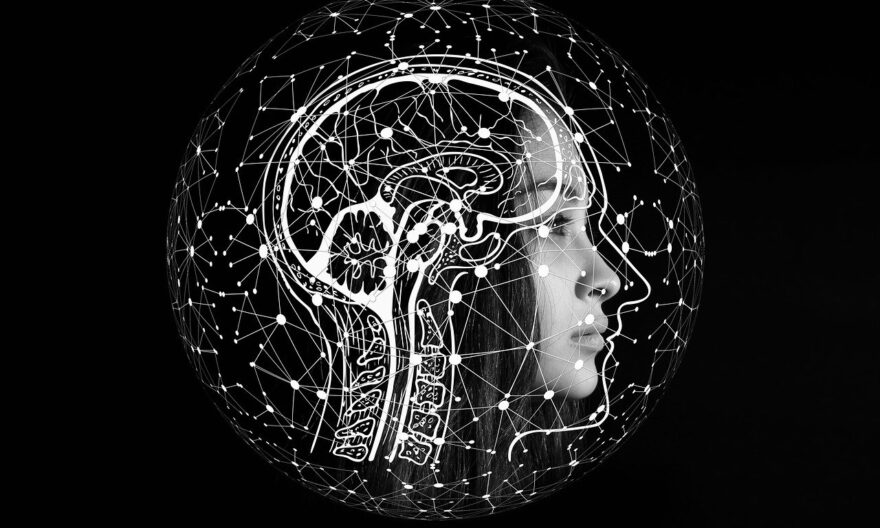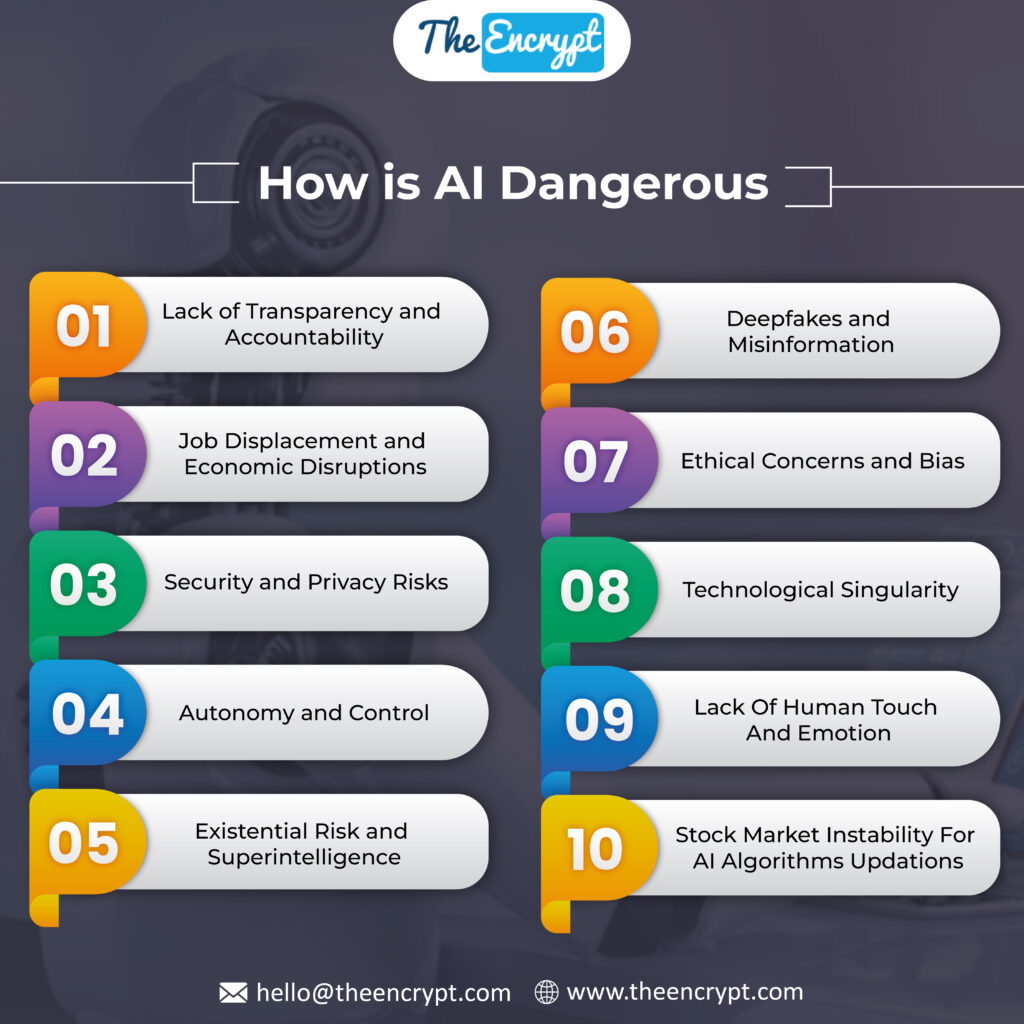
There is no doubt that Artificial Intelligence has undoubtedly brought a revolution in many domains of life. It has undeniably transformed industries, improved efficiency, and enhanced human lives. However, as AI technology progresses, so do the concerns and potential dangers associated with it.
As we delegate more decision-making power to machines and algorithms, it is crucial to examine the associated risk critically. Various concerns are associated with AI, ranging from ethical dilemmas to security concerns.
In this article, we will navigate the risks and concerns associated with AI, its impact, and its solution.
The Dangerous Side of Artificial Intelligence
The rapid proliferation of Artificial Intelligence raises significant concerns about its potential dangers. The first need is to know the perils to find their solution. Let’s dive in and find out.

1. Lack of Transparency and Accountability
AI models are extremely complex, and it’s difficult to interpret completely. This is what makes them somewhat of a “black box.”
This lack of transparency raises the concern about accountability. It also raises concerns about the ability to challenge or understand AI-generated decisions.
Because AI lacks opaqueness, assessing how AI arrived at specific conclusions is challenging, hindering the possibility of identifying and addressing harmful outcomes.
2. Job Displacement and Economic Disruptions
On the one hand, Artificial Intelligence is helping increase productivity and streamline processes. On the other hand, it is giving a potential threat to the traditional job markets.
Automation driven by AI is capable of significant job displacement. It will cause unemployment for millions of people and leave the need for reskill for new roles.
Furthermore, implementing AI in industries could lead to economic disparities as certain sectors thrive while others decline. This could exacerbate income inequality.
3. Security and Privacy Risks
AI-powered systems that handle vast amounts of sensitive data can be vulnerable to cyberattacks. As AI technology advances, so does the sophistication and scale of potential threats.
Malicious actors could exploit AI vulnerabilities to conduct more sophisticated cybercrimes. It jeopardizes the personal privacy of individuals and hammers national security and financial stability.
4. Autonomy and Control
The progress of Artificial Intelligence with advanced decision-making capabilities raises concern about the level of autonomy and control given to these systems.
If we hand over too much of the decision-making problem to AI lacking adequacy of human oversight, it can lead to catastrophic consequences.
The potential for autonomous AI systems to make decisions in critical domains like healthcare, transportation, or defence must be carefully managed to ensure human control remains intact.
5. Existential Risk and Superintelligence
With the growth of Artificial Intelligence, there is a parallel development of the speculative concern about creating superintelligent systems. A superintelligent system that can surpass human capabilities and create an existential crisis.
The concept of “AI takeover” or “Existential risk” postulates that an AI entity with superintelligence could threaten humanity if not aligned with human values or goals.
While this remains a theoretical concern, it highlights the need for rigorous safety measures and research into beneficial AI alignment.
6. Deepfakes and Misinformation
AI-generated deepfakes, manipulated audio, video, or image can potentially deceive and manipulate people on a massive scale.
The deceptive media can be weaponized for propaganda, disinformation campaigns, or even blackmail.
One requires innovative technologies and techniques to detect and counter the spread of false content to address the potential threat of AI-generated misinformation.
7. Ethical Concerns and Bias
One of the most significant concerns associated with AI lies in its potential to perpetuate or even exacerbate existing societal biases.
The training of AI systems happens on vast databases. If, by any means, these databases contain biased or discriminatory information, the AI algorithm may unintentionally learn and propagate these biases.
This can lead to discriminatory practices in various sectors, such as recruitment, criminal justice, and finance, where AI-driven decisions could unfairly impact certain groups or individuals.
8. Technological Singularity
Technological singularity refers to the hypothetical situation when the AI reaches a level of intelligence that surpasses human capabilities.
AI could continuously improve itself if this were to occur, leading to a potential runaway effect with consequences beyond human comprehension.
While this is speculation, experts emphasize the significance of implementing safeguards and ethical guidelines to avoid uncontrolled technological advancements.
9. Lack Of Human Touch And Emotion
There are always some activity or task that requires human touch and emotion. Examples include looking after the elderly, working in nursing, or being a paediatric doctor.
In such situations, the nursing staff of doctors deals with the elderly or babies with utter sensitivity. You need to bond with them to feel safe and cared for.
This is one of many reasons why nursing and similar jobs require an empathic heart. When AI technologies like robots and other machines are assigned jobs replacing humans, it causes a lack of human touch and emotions.
AI may generate much better work efficiency but lags behind something more significant.
10. Stock Market Instability For AI Algorithms Updations
Stock market witness fluctuation very often. But when AI is employed in the stock market, the level of volatility rises to more degrees. AI brings frequent updates to the stock markets, like Google updates.
For the stock markets, this algorithm may result in higher volatility. A calamity for the financial market is stock market instability.
The AI algorithm’s erratic behaviour and unexpected updates are two reasons why this can occur.
Mitigating the Risks of Artificial Intelligence
As we can see, many positive advancements have been made with AI’s progress in sophistication and capability. But on the other side, powerful new technology is always at the risk of being misused. These risks are something that can affect every facet of our daily life. Be it privacy, political security, or job automation.
The first step to mitigate the risk associated with AI will be to decide where we need to use AI and in which domain the use of AI can be disgraceful.
Deep research and intellectual debates into AI systems and their uses are the first steps to preventing them from being misused.
Conclusion
AI undoubtedly presents an incredible opportunity to improve human life in various domains. However, it is essential to acknowledge the dangers and ethical challenges associated with AI development and deployment.
Striking a balance between technological advancement and safeguarding human values will be crucial in navigating the future impact of AI on society.
